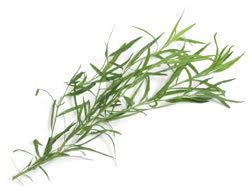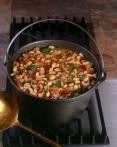 Tarragon is called the "King of Herbs" by the French, and with good reason. It is the main flavoring in many of the sauces that form the foundation of classic French cuisine, such as Bearnaise, rigavote and tartare. When paired with chopped sprigs of fresh parsley, chives, and chervil, you have the traditional seasoning blend known as fines herbs. This aromatic blend enhances the flavors of egg, chicken and fish dishes, and is also used as a basis for salad dressings. When using tarragon in cooked dishes, it is best to add it at the end, as heat tends to decrease its flavor. Unlike most of the other herbs, tarragon loses the potency of its flavor when dried. This may be one reason it is so frequently preserved in vinegar, which captures tarragon's essence and creates a tasty condiment that can be used in dressings, mayonnaise and as a zesty deglazing alternative to wine.
Tarragon is called the "King of Herbs" by the French, and with good reason. It is the main flavoring in many of the sauces that form the foundation of classic French cuisine, such as Bearnaise, rigavote and tartare. When paired with chopped sprigs of fresh parsley, chives, and chervil, you have the traditional seasoning blend known as fines herbs. This aromatic blend enhances the flavors of egg, chicken and fish dishes, and is also used as a basis for salad dressings. When using tarragon in cooked dishes, it is best to add it at the end, as heat tends to decrease its flavor. Unlike most of the other herbs, tarragon loses the potency of its flavor when dried. This may be one reason it is so frequently preserved in vinegar, which captures tarragon's essence and creates a tasty condiment that can be used in dressings, mayonnaise and as a zesty deglazing alternative to wine.
French tarragon (Artemisia dracunculus) is the variety most often used in recipes. Its flavor is sweeter and its leaves are more delicate than its relative Russian tarragon, (Artemesia dracunculoides), which tends to have coarser, paler leaves and a bitter, inferior flavor. Unfortunately, whereas the Russian variety spreads and reproduces easily, French tarragon cannot be propagated by seed but must be cultivated by cuttings and root divisions. For a healthy plant, it requires rich, well drained soil and full sun.
The true French Tarragon has the best flavor and cannot be grown from seeds as this plant will not flower. Cuttings must be taken in order to reproduce this plant which makes it more expensive and harder to find. Tarragon grows in full sun and will grow to about 2 feet or so across. It is most important that this plant have good drainage and it is a good idea to add sand or grow it in a large container to make sure the roots will not rot and die. It is perennial but you should try to bring it indoors, either a potted plant or take cuttings, to grow over the winter months as it sometimes does not come back the following spring because of wet soil.
To harvest Tarragon, remove a third of the branch and chop the leaves finely. Tarragon does not dry very well so freezing is the best method to preserve the flavor.
To use Tarragon in cooking, chop the leaves very fine to extract the flavor for cream sauces and Bearnaise sauce. Add it to tuna or chicken salads, eggs and quiches, mayonnaise's, and mustard salad dressings. It makes a wonderful flavored butter and can be combined with dill and parsley for fish.
*It is said you cannot dry it well but I get some from a health food store that sells dried herbs and the one I get is wonderful and keeps well. So if you can do that too ....test it. Perhaps home dried is not as good but larger places have quicker ways to dry than we do.

WHITE BEAN AND TARRAGON SOUP serves 4
8 ounces Great Northern white beans
2 Tablespoons olive oil
1 medium onion, diced
1 small fennel bulb, diced, about one cup
2 teaspoons grated lemon peel
2 cloves garlic, minced
7 cups chicken stock
1 Tablespoons fresh tarragon leaves, chopped
3 Tablespoons thinly sliced ham, julienned
salt and pepper to taste
Sort through the beans to remove rocks and other items. Put in a container and cover with four inches of water. Soak overnight. Drain off the water.
In a stainless steel pot heat the olive oil. Saute the onion and the fennel until golden. Add the grated lemon peel and the garlic. Cook for one minute to release the flavors. Add the stock, cover the pot and reduce the heat to a simmer. Cook the beans until soft, about one hour. Stir in the tarragon, reserving 1/2 teaspoon to use for garnish. Add the ham, stirring to blend all flavors. Add salt and pepper to taste. Ladle into decorative soup bowls and garnish with the remaining tarragon.

No comments:
Post a Comment